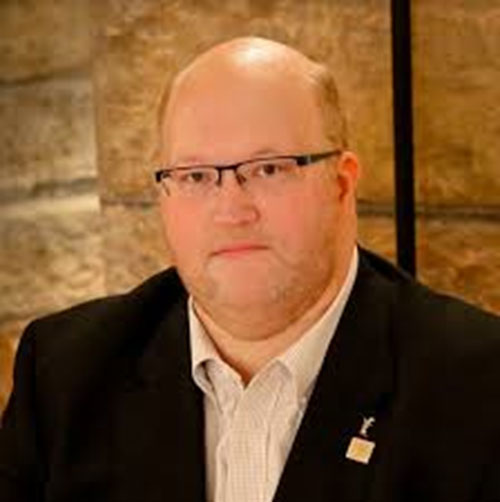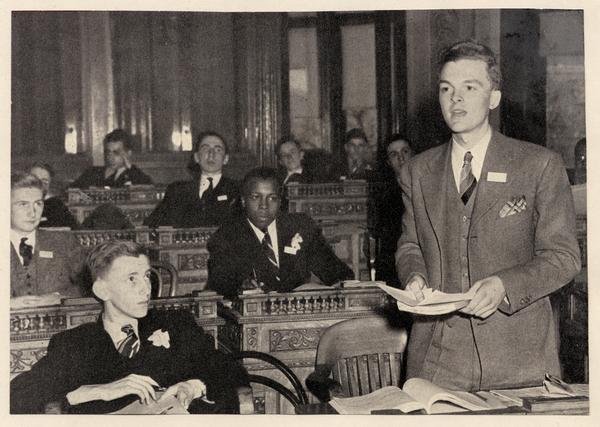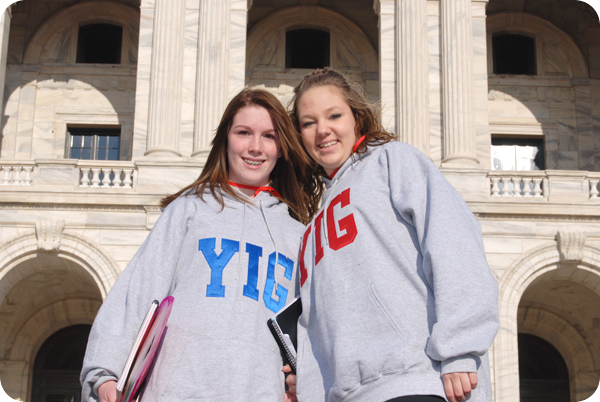1936
The first model legislature was held in Albany, New York.
1946
The first Model Assembly was held in Minnesota, held once every two years, and was comprised of the youth House and Senate and a Youth Governor.
1965
Youth in Government became an annual event. In addition to the writing and debating of bills, student legislators also contributed to a session newspaper, but the press corps was not yet a full program.
In the late 1960s and early 1970s the program suffered from low enrollment which can be attributed to that era’s apathetic feelings toward government as a whole. The addition of the Page program in 1972 and a team of assistants to the Governor in 1973 helped to attract new participants.
1970
The Minnesota program office was moved to Rochester, Minnesota where the program was offered as a service to all YMCAs in Minnesota. Prior to this move, the Youth in Government program was run by the North Central Area Council of YMCAs.
1974
The YMCA of Metropolitan Minneapolis became the home for the program and has continued to offer the program on a state-wide basis. With the guidance of a State Board for Youth in Government, the YMCA hires appropriate staff that sees to the day-to-day operation of the programs. The State Board has traditionally been made up of prominent officials in state government and concerned individuals from the community.
1975
Youth in Government underwent one of its most important changes; adding the Youth in Law program, consisting solely of a model Supreme Court. The program was developed with the help of the late C. Donald Peterson, Associate Justice of the Minnesota Supreme Court.
1976
The first full Executive Cabinet program was instituted.
1978
The Attorney General’s office was added.
1980
An official Newspaper Press Corps was added.
1981
The Lobbyist program was offered, thanks to lobbyist and board member, Larry Harris. The position of Secretary of State was added to keep track of bills between the Legislature and Executive Branches.
1982
Minnesota Youth in Government began participating in the National Affairs Conference.
1984
Minnesota introduced its first Video Press Corps, modeled after similar programs that had been successful in other states.
Youth Court of Appeals was created to respond the demand for participation in the Youth in Law program. This new court program was designed for 9th and 10th graders and coincided with the institution of an actual Court of Appeals in the Minnesota judicial system.
1985
Youth Court of Appeals was created to respond the demand for participation in the Youth in Law program. This new court program was designed for 9th and 10th graders and coincided with the institution of an actual Court of Appeals in the Minnesota judicial system.
The Freshman House came into being designed especially for 9th graders. This new program would both introduce first year legislative participants to the legislative system in a less intimidating setting as well as eliminate some of the stress on the House and Senate chambers caused by the growing numbers already in those legislative programs.
Youth in Government participants began participating in Model Sessions in other states such as Alabama, Illinois, Michigan, North Carolina, Texas and Wisconsin.
1990
Boot Camp, a leadership training experiences for smaller groups was added.
1991
The Freshman House was replaced by a two-body legislature for 9th and 10th grade students. The Humphrey House (named after the late Hubert H. Humphrey, former U.S. Senator and Vice-President), and the Stassen Senate (named after Harold Stassen former Governor and signer of the United Nations Charter). The Humphrey House and Stassen Senate are housed in the hotel ballrooms and allowed the legislative programs to reduce their sizes to the actual numbers of 67 Senators and 134 House members.
YIG Radio Station aired its first broadcast, operating early mornings, late afternoons and all night to entertain students when they are in their hotel rooms after hours.
1993
The conference settles into its final date pattern – gathering on the Thursday of the same week that the “real” Minnesota Legislature convenes.
1998
Lobbyist program divides into “junior” and “senior” areas to more effectively advocate for and against bills in the expanding legislative program areas.
1999
YIG moves to the Hilton Hotel in Minneapolis after outgrowing its long-time home at the Radisson Hotel in St. Paul.
The Sibley House and Ramsey Senate were added due to increasing program enrollment. Named for Henry Sibley, first State Governor, and Alexander Ramsey, first Territorial Governor, the Sibley House and Ramsey Senate also serve 9th and 10th grade participants.
To better serve the interests of the delegates and to expand participants in the government process, the Cabinet and Lobbyist programs underwent a division into Junior and Senior departments which were better-equipped to exert their influences on the legislative agenda. A similar phenomenon began in the Court of Appeals in the mid-1990s; with the advent of a one-day Trial Court model to enhance the appellate process for all judicial participants.
2001
A formal and full-time conference newspaper was added to the Model United Nations program.
2002
The functions of the youth-run State Steering Committee and Boot Camp were combined into a State Steering Committee Retreat, with required attendance from all Model Assembly delegations in the state.
Youth in Government conducts several training sessions of Officers and Appointed Officials of the Model Assembly, Model United Nations and National Affairs delegation, in addition to the Steering Committee retreat. These training sessions and retreats focus on the job responsibilities of program officers; to expand the horizons of youth leaders on responsible use of authority, power and responsibility.
2004
The Leadership Corps program area replaced the Page program and focuses 8th grade students’ experience on leadership development and issues exploration – helping students think about the topics that affect them, their families, and their communities.
2007
This is the final year of the Kellogg House and Wabasha Senate, since legislative growth for the older students did not materialize as anticipated – each of the four “upper” legislative bodies only topped out at 50% enrollment, resulting in lackluster floor debate.
2009
The Trial Court is initiated, marking a change from exclusive focus on Appellate courts at YIG and the start of a popular areas to meet the growing 9th and 10th grade population at YIG.
2011
The National Issues Forum program area is added, bringing the National Affairs conference experience to Minnesota, facilitating wider discussion of national and international issues rather than strictly-focused debate and up-and-down votes on only state issues as done in the legislature.
2012
The newest Media outlet is initiated – the Digital Media program – focused on texting, blogging, and amplifying the work of the other media outlets to larger audiences outside the conference environment.
2014
The Attorney General’s office is eliminated at YIG after spirited debate and a narrow vote by the State Steering Committee. District Court begins with a goal of expanding Trial Court experiences for 11th and 12th grade students with a twist – adding pre-trial motions and other complex elements that allow student attorneys and judges to flex the mechanics of the cases each time they come up for a trial.
2016
A major program “refresh” with LAUNCH begins, a re-focused, student-led training and development pre-conference event that prepares students for the session in January, taking the place of “Fall Kickoff,” “State Convention,” or “Pre-Leg Session” events of earlier years.
2019
Youth in Government (formerly known as Model Assembly) becomes the “crown jewel” of the new YMCA Center for Youth Voice, formed when Minnesota Civic Youth integrates into the Y. Conference programs including YIG, Model United Nations and the Conference on National Affairs are now augmented with Students Voting, the Student Election Judge Network, Youth Day at the Capitol and Respectful Conversations in Schools.
2020
The 2020 YIG conference takes place, serving more than 1,500 delegates, shortly before the nationwide COVID-19 shutdown.
2021
During the second year of COVID, Y staff pivoted to offer a virtual YIG conference to more than 500 delegates. All program meetings, and even some social events, including a dance party and talent show, took place over three days on ZOOM.
2022
YIG was held in person although masks and COVID were still ever-present throughout the four days. New names were announced during the session to replace Sibley House and Ramsey Senate to acknowledge new understandings of their namesakes and to update the name of the Stassen Senate. Sibley House became the Myers House, Ramsey Senate became Spear Senate, and Stassen Senate took the same Smith Senate (Humphrey House retained its original name).
This was also the year the focus shifted to running nearly all delegations out of schools rather than Y branches. Y youth development staff was never rehired after the pandemic and school-based delegations, led by educators, allowed more consistent program preparation and easier meeting opportunities for students.



